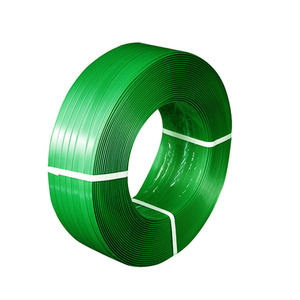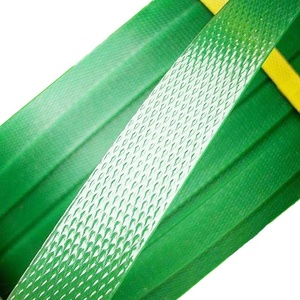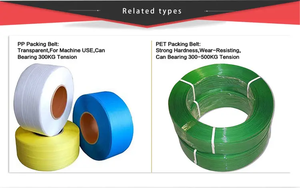(20872 products available)
























































































































































































































Plastic pet strap comes in different types. They are elaborated on below.
This type of plastic pet strapping is installed and tensioned by hands. It is mainly used in light and medium industrial packing. It is popular due to its low prices and flexibility. Manual strapping finds extensive application in small scale operations. It allows users to have control over each strap installation.
Automatic strapping systems use machines for tensioning, sealing, and cutting. They offer high speeds and consistency. Such features make them ideal for large production operations. They require less labor and decrease the time taken in the process. The system also increases the efficiency of packaging.
This falls in between manual and automatic systems. It requires human intervention for tensioning while using a machine for sealing. Semi-automatic PET strapping finds applications in medium capacity operations. They have flexible requirements. They balance speed with some manual control.
This is produced in a centerfold design. It allows for easy application in automatic and semi-automatic systems. This strapping option is cost-effective since it saves on carriage space.
Plastic pet straps come with distinct structural designs. They have unique characteristics that enhance their functional attributes.
The design consists of a single, thick strand of PET. It offers high tensile strength and durability. Manufacturers make use of the design in heavy-duty packaging applications.
This incorporates an additional reinforcing fiber into the strap. It can increase tensile strength and elasticity. The design offers better resistance to shocks and impacts. This option works best in irregularly shaped loads or in transport scenarios where they are subject to stacking.
This design features a roughened surface on the strap. It increases friction between the strap and the load. Higher friction prevents slippage during transportation or storage. This is ideal for use with smooth surfaces that are likely to cause slippage.
They consist of reinforced edges along the strap. The edges increase wear resistance at critical points. They particularly function where the strap is exposed to high tension. They help improve the life span of the strapping in heavy load applications.
The design has edges that can be manufactured in different widths along the length of the strap. It aims at optimizing the distribution of tension. This improves load stability. The systems help to adjust the width according to the specific requirements of the application.
Digital printing technology has improved the capability to print on plastic PET straps.
Digital printing allows for customized designs. This includes intricate patterns, images, or logos. It offers flexibility to produce straps that align with specific branding needs. This appeals to diverse businesses.
Digital printers offer high resolutions. They produce sharp, vibrant graphics on the straps. This enhances the overall attractiveness of the packaging. Improved print quality contributes positively to brand perception.
Recent advancements in ink formulation involve eco-friendly substances. These reduce the environmental impact of the printing process. They are less likely to produce harmful emissions compared to traditional solvents.
The advent of digital printing reduces the costs of creating custom designs. It eliminates the need for expensive plates or setups during the printing process. This makes small production runs more financially viable.
Digital printing provides quick adjustments. They lead to faster production times. Businesses are able to respond promptly to market demands. Such speed meets the need for tightly scheduled supplies.
There are several considerations a buyer has to take into account when choosing a plastic strap pet. Below is a guide on the matter.
Different types of plastic pet strapping have varying strength-holding capacities. Some are suited for light cargo while others are suited for heavy ones. Manufacturers make pet plastic strapping belts for heavy loads from thicker and wider straps. The belts have higher tensile strength. Marguerite had plastic strapping for light and stable loads.
The width of the strapping is important as it affects the distribution of the tension. If the strap has a wider width, it will spread evenly across the surface of the load. It reduces the chances of damaging the products being transported. If the load is heavy, go for a wider strap. Plastic pet strapping also comes with diverse thicknesses. A thicker strap offers greater strength. Thin plastic strapping is flexible and offers ease of usage. However, it is less supportive of heavy loads.
Certain environmental factors such as humidity, temperature, and exposure to chemicals affect the types of plastic pet strapping to go for. Some types have been designed to resist UV rays, moisture, and temperature variations. These make them ideal for outdoor storage and transportation. UV-resistant plastic pet strapping is thicker for outdoor usage.
If the products being transported have smooth surfaces, go for textured pet plastic strapping. It will have a rougher surface that increases friction. It will prevent slippage during transportation. Also, printed pet plastic straps are designed for use with different types of materials. They come with specific addendums that make them suitable for extending the life of the load.
Plastic pet strapping is available in manual, semi-automatic, and automatic applications. It makes it easy to select one that is compatible with pet strap machines. This ensures the efficient installation and tightening of the strap around the load.
No. Plastic pet strap has a high resistance to moisture. This makes it ideal for applications where corrosion is a risk. PET's chemical structure provides UV and weathering resistance. They protect against environmental wear. This low maintenance requirement and durability ensure long-lasting performance.
Manufacturers use different types of additives when making plastic pet straps. They include anti-slip additives, chemical resistance agents, colorants, and UV stabilizers. Anti-slip additives increase friction between the strap and load. This prevents slippage during transportation. Chemical resistance agents protect the strap from breaking down due to exposure to chemicals.
The primary factors that affect the longevity of pet strap are environmental exposure, tension variations, and temperature extremes. Constant exposure to UV rays can degrade the materials. High and low temperature extremes affect the materials. UV rays reduce flexibility. On the other hand, low temperatures make the material brittle. Excessive tension can cause premature wear. Insufficient tension allows slippage and lack of load support. Both of them have a toll on the strap.
There are several methods of disposing of waste plastic pet strap. They include recycling, incineration, and sending them to a landfill. In recycling, the straps are cleaned and processed into new materials. It is affordable and reduces the need for virgin PET. Another method, incineration, generates energy. It also reduces the volume of waste but emits harmful substances. Landfilling is the least preferred method. It results in strap lasting for years and terracing the landfill space.